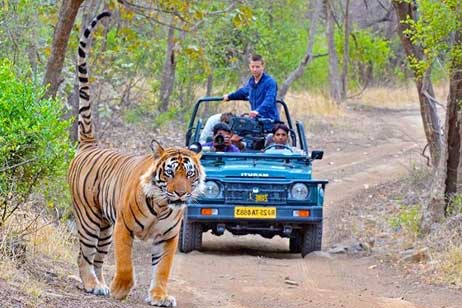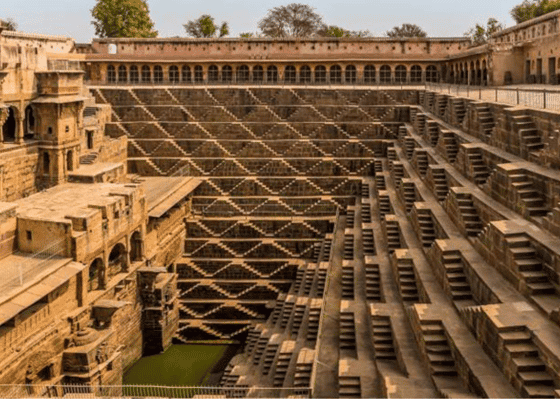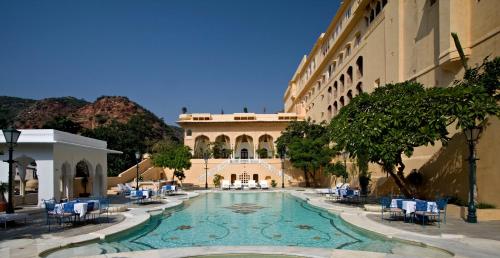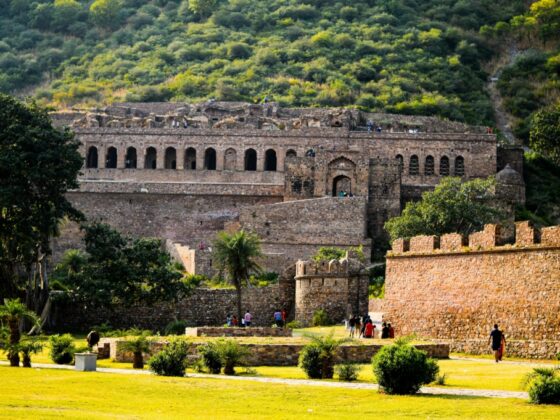Exploring Ranthambore: A Thrilling Jungle Safari Experience
The thrill of venturing into an unknown destination is akin to mastering a new language. One can immerse oneself in travel guides, maps, and even “Jungle Safari for Beginners.” However, just as language learners must eventually engage with native speakers, a traveler must embrace the wilderness firsthand. The anticipation of encountering wildlife in its natural habitat is exhilarating, but the experience itself is unpredictable—an adventure that keeps the heart racing.
I write this from the tranquil confines of my garden-facing room at Fort Nahargarh, nestled in the heart of Ranthambore, Rajasthan. Located approximately 126 km from Jaipur, Ranthambore is a world-renowned wildlife sanctuary spanning 400 square kilometers. It is perched on the Aravalli mountain ridge, a range stretching from Delhi to Gujarat, covering nearly 7,000 hectares. The park primarily consists of dry deciduous forests, with patches of moist deciduous vegetation, offering an ideal habitat for diverse flora and fauna.
Safari Trails and Wildlife Encounters
Ranthambore boasts multiple safari routes leading to rust-colored rivers, limestone cliffs, and mysterious caves. These trails vary in length, spanning 20 to 30 km, and offer varying levels of difficulty. The park operates from 6:00 a.m. to 6:00 p.m. daily, and visitors can opt for either a jeep or bus safari. The best chances of wildlife sightings occur during the 6:00 a.m. and 5:00 p.m. safaris. The safari costs Rs. 500 per person for a 20-seater bus and Rs. 750 per person for a six-seater jeep, each lasting approximately 150 minutes.
Ranthambore is home to an array of wildlife, including tigers, leopards, crocodiles, sloth bears, sambar deer, barking deer, and wild boars. Spotting a Royal Bengal Tiger is rare but possible with patience. Staying for at least three to four days and taking multiple safaris increases the likelihood of an encounter. On my first visit to Simlipal Tiger Reserve in Odisha, I was fortunate to spot a tiger within 30 minutes of entering the forest. However, at Ranthambore, tiger sightings are usually more elusive, with successful sightings occurring once every six safaris on routes 4 and 5.
The Safari Experience: A Journey Through the Jungle
As the jeep winds through dense bamboo groves, khejri trees, and rocky terrain, the journey is as thrilling as the destination. The first stretch involves a slow, winding ascent through a mud road, offering breathtaking views. Wildlife encounters begin early, with spotted deer, wild boars, and sambar deer frequently crossing the trails. The air resonates with the sounds of chirping sparrows, calling hornbills, squeaking monkeys, and screaming peacocks.
Driving deeper into the jungle, the terrain shifts to pebbles, roots, and twigs, making navigation challenging. Several small lakes emerge, serving as watering holes for tigers. My forest guard informed me that tigers are often sighted at these watering holes during early mornings and late evenings. Having visited Kanha, Bandhavgarh, Corbett, and Rajaji National Parks, I was thrilled to spot seven tigers during my three-day stay at Fort Nahargarh.
One of the most memorable moments was watching a sub-adult tiger stealthily approach a mountain stream, quench its thirst, and rest under the shade of an ancient tree. On the return journey, we were fortunate to witness a tiger drinking water at close quarters—an unforgettable experience!
Accommodation: Fort Nahargarh – A Royal Retreat
For those seeking luxurious stays, Fort Nahargarh is an unmatched choice. With 68 elegantly designed rooms, this palace-style resort offers an immersive experience amidst nature. The deluxe double-room rates range from Rs. 14,000 to Rs. 18,000 per night, inclusive of breakfast but exclusive of taxes. The property features manicured gardens, a stepwell, and an opulent dining hall, reflecting authentic Rajputana architecture.
During my stay, I was impressed by the impeccable room ventilation, allowing a comfortable nap at 40°C without air conditioning. Soya milk options for vegans and an array of vegetarian dishes were delightful. Special thanks to Mr. Mahipal Singh (GM), Mr. Shravan Maini (Spa), and Mr. Dhruv Alsisar (Owner) for their hospitality and attention to detail.
Dining and Refreshments
Breakfast at Fort Nahargarh includes hot idlis with coconut chutney, alongside an array of fresh fruits like bananas, papayas, and tender coconuts. Travelers can also stock up on seedless dates, walnuts, raisins, and cashews for a quick energy boost during safaris. Vegetarian dhabas in Sawai Madhopur offer roti, dal, and aloo ki sabzi, providing simple yet satisfying meals.
Getting to Ranthambore
The nearest international airport is in New Delhi, while the closest domestic airport is in Jaipur. Travelers can choose from multiple options:
- By Air: Direct flights connect Jaipur to Mumbai, Delhi, Chennai, and Kolkata. The 166 km journey from Jaipur to Ranthambore takes three hours by car or four hours by RSRTC buses.
- By Train: A train from Jaipur to Sawai Madhopur takes two hours. From there, local taxis are available to reach Fort Nahargarh. Avoid overpriced private jeeps and opt for state-run transport.
Alternative Wildlife Spotting and Activities
Beyond the tiger safaris, leopards can be spotted near RTDC Guest House, and peacocks can be seen on early morning treks near the forest. I had the opportunity to embark on an early morning nature walk, photographing chinkaras, peacocks, and spotted deer. Fort Nahargarh’s watchtower offers a panoramic view of the jungle, enhancing wildlife spotting opportunities.
Relaxation: A Soothing Spa Experience
After an adventurous safari, Vilasa Spa at Fort Nahargarh provides the perfect retreat. Managed by Mr. Shravan Maini, the spa offers a range of herbal compress treatments. Special mention to acupressure expert Mr. Luang from Nagaland, whose expertise helped relieve post-safari aches and pains. The dim lighting, soothing music, and expert therapy create a blissful experience, making a visit to Fort Nahargarh worthwhile for the spa alone.
Final Thoughts
My experience at Ranthambore and Fort Nahargarh was nothing short of extraordinary. The thrill of tiger spotting, the serenity of nature walks, and the unmatched luxury of Fort Nahargarh made this journey unforgettable. As I bid farewell to Mr. Mahipal Singh, I eagerly set off to explore the leopards at Devigarh and blackbucks at Chandelagarh, concluding my wildlife adventure with a peaceful retreat at Dera Mandawa boutique resort in Jaipur.
For bookings at Fort Nahargarh, email alsisar@alsisar.com. If you’re planning a Ranthambore safari, opt for routes 4 or 5 for the best chances of spotting a tiger. With patience, the jungle might just reveal its most elusive resident to you!










